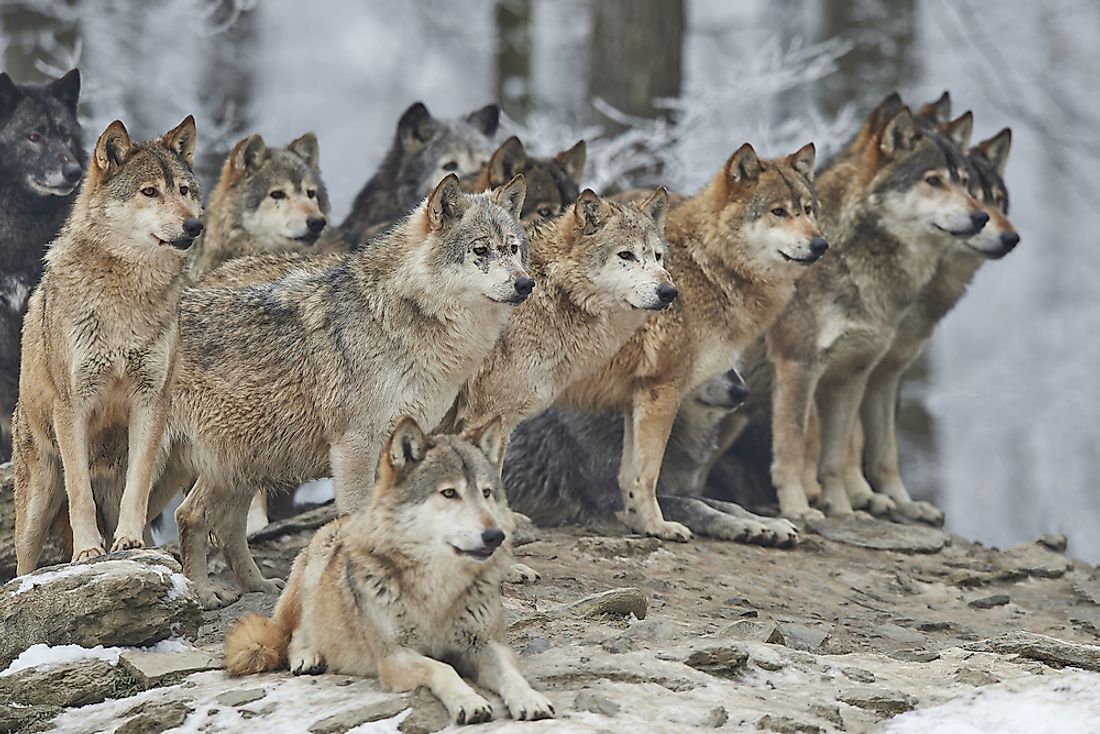Where Do Wolves Live?

A wolf is a large wild canine that resembles a dog. Wolves are of the Canidae family and assigned a specific name, Canis lupus. Other names include; grey/gray wolf, western wolf, and timber wolf. They typically have grey fur but others have pure white, red, or brown and in some instances a mixture of both. A male wolf weighs up to 99 pounds while the female wolf up to 85 pounds. There is an acute disparity in the lifespan of a wolf but it ranges between six to eight years. Wolves are found in remote regions of Eurasia and North America.
Behavior and Communication
These canines are social beings, organized in family units called packs. Male and female parents form a pack that consist of mostly their adult offspring forming averagely between five to ten animals. Some packs may have up to three families. A wolf leaves the pack upon sexual maturity to form a new pack or when competition for food is high. A wolf pack normally play hostile to strangers but in rare circumstances packs temporarily combine forces. Wolves use their distinct howls, strong sense of smell, and visual signals including facial expressions, tail positions, and piloerections to communicate.
Ecology: Habitat, Diet, Enemies, and Competitors
Wolves are habitat generalist due to their adaptability in forests, deserts, grasslands and snowy terrains. Female wolves built dens where members of the pack stay. Generally, they feed on large ungulates and occasionally on smaller animals or large insects, with fruits and vegetables as supplements. However, wolves may feed on carrions or even cannibalize in dire situations. Wolves compete with other animals like coyotes, bears, jackals, foxes, dholes, hyenas, and cougars for food which may escalate to the killing of each other’s young ones. Humans and tigers are the main predators of wolves.
Distribution of Wolves
Europe
Wolves were once widespread in Europe. Hostility between wolves and humans started in the Middle Age and intensified in the fifteenth and sixteenth centuries when countries like England enforced their legal persecutions. The majority of countries in Europe, except the Eastern part, had exterminated the entire wolf population by the 19th century. Germany was the first country to initiate legal protection on wolves in 1934. European wolf populations began rising after the 1950s with the change of the economic paradigm thus making persecution of wolves unnecessary. The wolf population has since increased with most of the countries placing the species under protection.
Asia
The population of wolves in Asia grew relatively up to the nineteenth century in most Asian countries including Russia, Japan, Mongolia, and parts of India. However, farmers targeted and killed most wolves because of attacks on humans and livestock in the early twentieth century leading to their extinction in Japan by 1905. The population started increasing towards the end of the twentieth century. Today, a large number of wolves live in Russia, China, Israel, Turkey, and Saudi Arabia, Jordan, Afghanistan, Pakistan, northern India, and Mongolia.
North America
Historically, the whole of the region above 20°N in North America was home to wolves. The lessening wolf population came about because of the increase in human populations who turned wolf habitats into agricultural fields. Between the 1860s and 1870s, wolf population declined after the extermination of the main prey for the species and further, state-sanctioned eradication of the wolves in US and Canada in the early twentieth century reduced the numbers further. The number of wolves started increasing again in the mid-1970s after the abolishment of the deadly campaign against the species. Currently, wolves inhabit Canada and northern states of the US.
Threats and Conservation
Diseases and human activities are the main threats facing the existence and conservation of wolves. Viral, bacterial, and parasitic infections like rabies, canine distemper and parvovirus, leptospirosis, and Dioctophyma renale, can hamper the normal functioning of a wolf or cause death. The encroachment of humans into the wolf habitat possess a great risk to conservation and aggravates human-wolf conflict. Wolf predation on domesticated animals and attack on humans, has led to bitter encounters with humans, who retaliate by hunting and killing the wolves. Conservation measures like legal protection on wolves have since been implemented to the advantage of the species.







